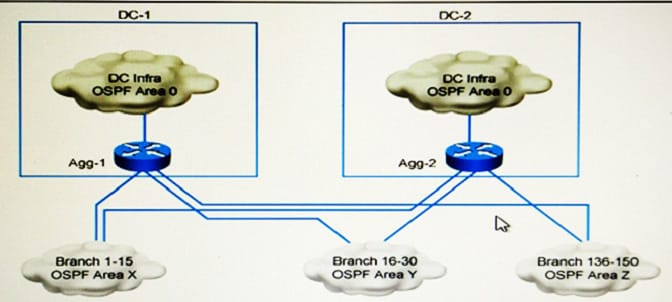Exam Details
Exam Code
:352-001Exam Name
:CCDE WrittenCertification
:Cisco CertificationsVendor
:CiscoTotal Questions
:705 Q&AsLast Updated
:Jul 03, 2023
Cisco Cisco Certifications 352-001 Questions & Answers
-
Question 61:
Which two options must be part of your network design to support dynamic mutual redistribution between multiple OSPFv2 and IS-IS boundaries, to avoid suboptimal routing? (Choose two)
A. Matching OSPF external routes
B. Route aggregation
C. Route tagging
D. Route filtering
E. Disabling IS-IS wide metrics
-
Question 62:
Refer to the exhibit,

company xyz has 150 branch location across the U.S. Each branch is connected to two aggregation router one router in each data center The network is configured with Multiple OSPF with multiple OSPF areas and the aggregation router are ABRs A requirement is to keep an optimal path to the data centers and at the same time reduce the LSA propagation and SPF recomputation during a change in any part of the network
Which design elements should be included on the aggregation router?
A. OSPF NSSA
B. distribute lists
C. OSPF summarization
D. OSPF totally stubby area
-
Question 63:
Which two are IoT sensor-specific constraints? (Choose two)
A. Memory
B. Processing power
C. The amount of devices
D. Cooling
E. Standard transport protocols
-
Question 64:
Which interconnectivity method offers the fastest convergence in the event of a unidirectional issue between three Layer 3 switches connected together with routed links in the same rack in a data center?
A. Fiber Ethernet connectivity with UDLD enabled
B. Copper Ethernet connectivity with BFD enabled
C. Fiber Ethernet connectivity with BFD enabled
D. Copper Ethernet connectivity with UDLD enabled
-
Question 65:
A network has several routers running IS-IS L1L2 mode on the same Ethernet segment. Which action reduces to a minimum the number of IS-IS adjacencies in this segment?
A. Define only the router on the segment to be DIS
B. Change all routers connected to this segment to a single-level area
C. Make the interface priority on the backup DIS lower than the primary DIS
D. Change half the routers to be L1-only and other half to be L2-only on this segment
-
Question 66:
As network designer, which option is your main concern with regards to virtualizing multiple network zones into a single hardware device?
A. Fate sharing
B. CPU resource allocation
C. Congestion control
D. Security
E. Bandwidth allocation
-
Question 67:
Which option lists the cloud service models?
A. Internet as a Service, Platform as a Service, and Storage as a Service.
B. Infrastructure as a Service, Platform as a Service, and Storage as a Service.
C. Infrastructure as a Service, Platform as a Service, and Software as a Service.
D. Internet as a Service, Product as a Service, and Storage as a Service.
E. Internet as a Service, Platform as a Service, and Software as a Service.
-
Question 68:
An ISP provides VoIP and internet services to its customers. For security reasons, these services must be transported in different MPLS Layer 3 VPNs over the ISP core network. The customer CEs do not have the ability to segment the services using different VLANs and have only one uplink interface that does not support VLAN tagging. How should you design the network to ensure that VoIP traffic that is received from the CE goes in the VoIP VPN, and that Internet traffic goes into the Internet VPN on the ISP PE devices?
A. Use a secondary interface IP address to differentiate between VoIP and Internet traffic
B. Extend the Layer 3 VPN toward the CE
C. Enable NBAR on the PE to direct the traffic into the correct VRF
D. Use a subinterface on the PE for each service, VoIP and Internet, with different subnets
E. Use policy-based routing to direct traffic into the correct VRF
-
Question 69:
Refer to the exhibit.

An enterprise has three sites over a Layer 2 Metro Ethernet ELAN service. 100Mb/s and 10 Mb/s links have been provisioned to provide redundancy for the head office. When OSPF routing enabled to provide connectivity and the correct bandwidth statement has been applied to each interface, the branch sites observe two equal-cost routes to the head office. The enterprise wants to send all traffic through the 100 Mb/s link and use the 10Mb/S link strictly as a backup. Which OSPF network type must be set to ensure that the head office 100 Mb/s circuit is preferred over the 10 Mb/s circuit, at the same time minimize the amount of configuration required on all of the routers throughout the network?
A. NBMA
B. Point-to-multipoint
C. Point-to-point
D. Broadcast
-
Question 70:
Which three processes are part of the ITILv3 Service Operation? (Choose three)
A. Release and deployment management
B. Problem management
C. Incident management
D. Event management
E. Service-level management
F. Change management
Related Exams:
300-915
Developing Solutions using Cisco IoT and Edge Platforms (DEVIOT)300-920
Developing Applications for Cisco Webex and Webex Devices (DEVWBX)352-011
Cisco Certified Design Expert Practical500-052
Cisco Unified Contact Center Express500-173
Designing the FlexPod Solution (FPDESIGN)500-174
Implementing and Administering the FlexPod Solution (FPIMPADM)500-201
Deploying Cisco Service Provider Mobile Backhaul Solutions500-210
SP Optical Technology Field Engineer Representative500-220
Cisco Meraki Solutions Specialist500-230
Cisco Service Provider Routing Field Engineer
Tips on How to Prepare for the Exams
Nowadays, the certification exams become more and more important and required by more and more enterprises when applying for a job. But how to prepare for the exam effectively? How to prepare for the exam in a short time with less efforts? How to get a ideal result and how to find the most reliable resources? Here on Vcedump.com, you will find all the answers. Vcedump.com provide not only Cisco exam questions, answers and explanations but also complete assistance on your exam preparation and certification application. If you are confused on your 352-001 exam preparations and Cisco certification application, do not hesitate to visit our Vcedump.com to find your solutions here.